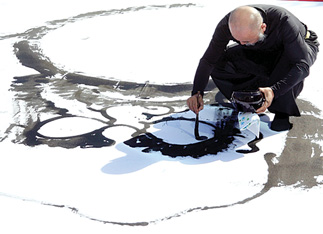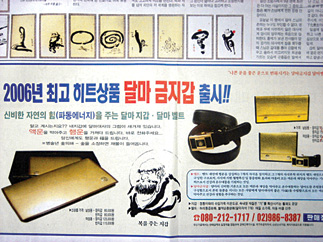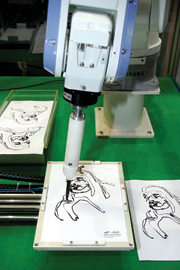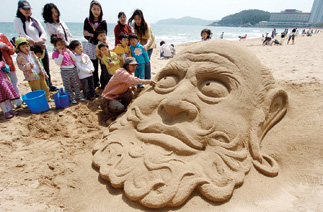A picture is worth lots of won

Drawing a painting of the legendary Buddhist monk, widely known here as the Dharma, has become a performance in itself. For some business people, the paintings have become a source of money. [JoongAng Ilbo]
“After I hung the painting in my bedroom the pain from my condition and my high blood pressure began to fade away,” she said.
Ahn asked for additional copies of the Dharma painting for her two sons ― one is in the the military and the other is studying in the United States.
“The paintings brought me great comfort, and my two sons feel the same way,” Ahn said.
Ahn was given the painting by the Venerable Seokju, during a Dharma painting event at the Jogye Temple in Seoul in 2005.

The Dharma has been an artistic favorite for centuries. From top: Junggwang’s portrait, poet Kim Ji-ha’s painting, and one of the most famous Dharma paintings by Kim Myeong-guk from the Joseon Dynasty. [JoongAng Ilbo]
Today Bodhidharma’s image is better known on good luck charms and amulets intended to ward off evil and it has become a lucrative product for business people who, according to some, are preying on people’s weaknesses.
The paintings and prints of the Venerable Haewoon, a Buddhist monk, were a huge hit on the Woori Home Shopping Channel last year, selling at a rate of 150 million won ($161,000) per hour.
Type in “Dharma painting” on an Internet portal site and a long list of Internet shopping sites will appear offering Dharma paintings, Dharma wallets, Dharma cell phone accessories and Dharma belts. A set consisting of a Dharma painting, belt and cell phone accessories was selling for some 200,000 won at an Internet site last week. Customers were offered inducements in the form of free gifts, such as made-in-Japan frying pans.
Those selling the paintings claimed that they reduced harmful forces by giving off a good, strong energy. In 2005, home shopping channels that had been airing a similar message, without offering any scientific basis, were ordered to desist by the Korean Broadcasting Commission.
Choi Soon-taek, the author of “The World of Dharma Paintings,” dislikes the idea of the paintings being used to make money. “It’s the most absurd fraud,” she said.
Seokju is proud that he does not charge for his drawings. “I have offered tens of thousands of copies of my Dharma paintings for free,” he said, referring to his gifts as an “act of offering alms.” He lowered his voice and thundered with glaring eyes, “Those who draw Dharma paintings to make money will burn in hell forever,” although he admitted that he has taken “donations” from believers to pay the 600,000-won monthly rent for his new office, which he calls the “Dharma Cafe.” The office opens today in a humble building with smelly, slippery stairs near Yeonsinnae, northern Seoul.
“It’s not like just anybody can do a Dharma painting,” said the monk. “You need a pure and faithful attitude.” Then he took a piece of mulberry paper, knelt down and held a brush. Using everyday ink and water from a Samsung teakettle, Seokju drew a painting in less than five minutes. With just a few strokes of different shades and size, a Dharma painting, believed to have the power to cure sickness and defeat evil, was born.
“Dharma paintings communicate with the viewer,” he stressed, “The mindset and attitude of the spectator determines what they can feel and use from the power in the paintings.”
Ahn, Seokju’s disciple, echoed his sentiments. “It’s not that the paintings are a cure-all,” she said. “It all depends on the mindset of the viewer.”
“We should not negate the power of the Dharma paintings themselves,” said Seokju. “There is power in the paintings.”
To make his point, Seokju wanted to offer his Dharma paintings as a free gift to those who buy today’s JoongAng Daily. “It’s my special service to your readers,” Seokju said. “I am sure that your paper will soon add millions of subscribers, thanks to Dharma,” he added, after his offer was declined. The day after he sent a text message, saying, “After drawing the eye to the Dharma painting, there is a spark of light from the sky.”
At least Seokju has not been blinded by the flash of money, unlike the Venerable Haewoon, one of the best known Dharma painting gurus, whose works have made millions on TV and in Internet shopping malls. According to Seokju’s theory, Haewoon is sure to burn in hell. His Web site introduces different kinds of drawings for sale with a telephone number that connects to the Dharma Zen Center in Busan.

A newspaper ad on the hit Dharma products, such as belts and a gold purse. Dharma has become a cultural icon, instead of a legendary Buddhist monk.
A call to the center is directed to a receptionist with a kind, gentle voice who says: “For those who order the paintings directly from us, instead of Internet shopping malls, the Venerable Haewoon draws them himself. It’s not just a print like the one that was a big hit on the home shopping channel.”
Asked if the advertised effects of the paintings have been scientifically verified, the receptionist became cagey ― “Such power is a mystery and not something that science can verify,” she said.
After learning that she was speaking to a newspaper reporter her tender voice turned sharp. “Why do you want to know that?” she said. “You’re strange.” Then she hung up the phone.
Dharma was an icon in Korean culture long before it was used as a money-maker on the Web. The India-born monk, who is usually pictured with big, flaring eyes and bushy whiskers, is a familiar image.

There is even a robot that draws Dharma paintings.
There is even a “Dharma Painting Motel” in Yeosu city, South Jeolla.
A recording from the motel’s switchboard says that all guests who stay overnight will be offered a Dharma painting for free.
Performances of Dharma painting have become an attraction ― it was one of the cultural treats that the Korean government offered to foreign guests at the 2005 Asia-Pacific Economic Cooperation gathering.
Choi, who is also a professor of archaeology and art at Wonkwang University, spurns the commercial frenzy now associated with the paintings. “In a word, it’s just preposterous,” Choi said. “Drawing Dharma should be a means of Zen training for Buddhist monks, not way to make a fortune.”
Drawing Dharma had previously been limited to certain artists and Buddhist monks. One of the most famed Dharma paintings is by Kim Myeong-guk, who worked in the 17th century during the Joseon Dynasty (1310 to 1910). His paintings are also acclaimed in Japan.
Dharma is associated with some legendary tales. One well-known anecdote concerns the first encounter between a Buddhist monk and the Emperor Wu of Liang Dynasty, who ruled China from 502 to 549.

A Dharma sand sculpture. [JoongAng Ilbo]
The emperor was astonished and asked the man who he was. The Buddhist monk replied, “I do not know,” illustrating his transcendence of self.
“The teachings of the Bodhidharma and commercialism are at odds with each other,” said Park.
Park said that Bodhidharma is a respected figure of Zen Buddhism, who “introduced a new way of understanding so that all of us can reach true happiness by overcoming human sentiments such as attachment and greed.”
“It’s quite ironic that people are selling and buying the paintings because of their attachment to greed and money,” Park said. “The core of Dharma’s precepts is to break all the icons and idols and to overcome greed and hopes of fortune. But Dharma himself has become an idol for people and a source of money for businesses.”
Choi dislikes the businesses who have jumped on the Dharma bandwagon but she still has a little sympathy for those who buy the paintings.
“The phenomenal success of the paintings is proof that people are troubled,” she said, “They are desperate to find some relief for their anxiety, and, in some cases it just happens to be Dharma. It would show a better understanding of Dharma if the buyers realized that everything that happens in their lives is the result of the decisions they make and has nothing to do with a mere painting.”
By Chun Su jin [sujiney@joongang.co.kr]










with the Korea JoongAng Daily
To write comments, please log in to one of the accounts.
Standards Board Policy (0/250자)